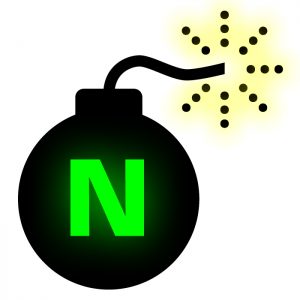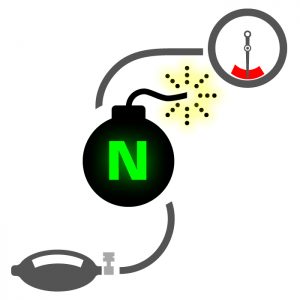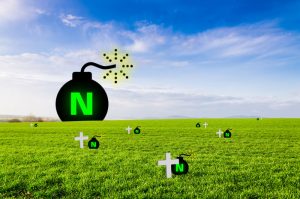Synthetic hallucinogens provide legal but dangerous ways to distort an individual’s perception of reality. Although feelings of panic and fear often accompany their use, these drugs continue to rise in popularity due to easy accessibility and ability to elude detection by standard drug screenings.
It’s the Bomb
Synthetic hallucinogens, which are alternatives to lysergic acid diethylamide (LSD), change the way a person perceives the world and can affect all the senses by altering thinking, sense of time and emotions. Most synthetic hallucinogens fall into the N-methoxybenzyl (NBOMe) classification, thus leading to the common street terminology, “N-Bomb.” Initially, according to the United National Office on Drugs and Crime (UNODC), NBOMe’s were developed for assisting with the mapping of serotonin receptors in the central nervous system. However, these substances quickly found nonmedical uses and were sold as the legal or natural alternatives to LSD or deceptively as LSD.
 Three varieties of this drug exist and are differentiated by their chemical structure: 25I-NBOMe, 25C-NBOMe and 25B-NBOMe. These NBOMe substances have been detected in blotter papers, powders, capsules and liquids. Some key facts about NBOMe substances include:
Three varieties of this drug exist and are differentiated by their chemical structure: 25I-NBOMe, 25C-NBOMe and 25B-NBOMe. These NBOMe substances have been detected in blotter papers, powders, capsules and liquids. Some key facts about NBOMe substances include:
- Discovered in 2003 by scientist at the Free University of Berlin
- Sold online as a designer drug in 2010
- Derived from mescaline, which occurs naturally in peyote cactus
- Ingested the same way as LSD
- Included street names are Smiles, 25B, 25C and 25I
- Generated long-term damage to kidneys, including kidney failure
Healing or Harming
 During the 1950s and early 1960s, hallucinogens, primarily LSD, were used by the medical community as a way to gain a better understanding of schizophrenia and to treat mental disorders, such as alcoholism and depression. However, in the late 1960s, a counterculture developed in the United States based on love, peace, happiness and psychedelic drugs. A former Harvard psychologist and strong supporter of the drug, Timothy Leary, stated the resounding call for using LSD, “Turn on! Tune in! Drop out!” More and more individuals were experimenting with the drug as a way to unlock their hidden consciousness. During this time, a significant growth in hospital emergency visits and paranoid and delusional individuals being locked up in jail cells occurred. The Controlled Substance Act of 1970 made LSD a Schedule I drug, the classification for substances with high potential for abuse and absolutely no medical uses.
During the 1950s and early 1960s, hallucinogens, primarily LSD, were used by the medical community as a way to gain a better understanding of schizophrenia and to treat mental disorders, such as alcoholism and depression. However, in the late 1960s, a counterculture developed in the United States based on love, peace, happiness and psychedelic drugs. A former Harvard psychologist and strong supporter of the drug, Timothy Leary, stated the resounding call for using LSD, “Turn on! Tune in! Drop out!” More and more individuals were experimenting with the drug as a way to unlock their hidden consciousness. During this time, a significant growth in hospital emergency visits and paranoid and delusional individuals being locked up in jail cells occurred. The Controlled Substance Act of 1970 made LSD a Schedule I drug, the classification for substances with high potential for abuse and absolutely no medical uses.
These days, scientists have returned to researching hallucinogenic drugs as potential medical tools. Psilocybin, the psychoactive ingredient in so-called magic mushrooms, is being studied at major research institutions as methods for treating substance addiction, depression, obsessive compulsive disorder (OCD) and post-traumatic stress disorder (PTSD). But scientists still warn of potential dangers.
Synthetic hallucinogens are even more deadly since they can be produced outside of a controlled laboratory environment by anyone with a rudimentary understanding of chemistry. Although it was made from two banned drugs, N-bombs were not technically illegal until recently.
Sweeping through the country
 Although the exact number is not known, the amount of deaths attributed to N-Bombs is growing around the country. Some of the deaths include:
Although the exact number is not known, the amount of deaths attributed to N-Bombs is growing around the country. Some of the deaths include:
- 2012: North Dakota teen found dead after fatal reaction; 17-year-old Minnesotan ingested the drug with chocolate and died three days later; 21-year-old Arkansas male died after intranasal use
- 2013: Pennsylvania high school student overdosed on the drug, stopped breathing and died; 18-year-old Arizona male lost consciousness and died after taking the drug via nose drops
- 2014: 15-year old from Washington ingested 25I-NBOMe and mushrooms, vomited, seized and died from multi-system organ failure; high school student from Indianapolis was found dead in his home with the drug near his body on blotter paper
Feds have taken notice
While no major violent crimes associated with its use were reported, the rapid number of NBOMe-related deaths waved a red flag to the government. In 2013, the U. S. Drug Enforcement Administration (DEA) added 25B-NBOMe, 25C-NBOMe and 25I-NBOMe to Schedule I drug classification using its emergency scheduling powers. This made these NBOMe compounds “temporarily” Schedule I for two years. In November 2015, the temporary scheduling was extended for an additional year. How the government will handle its classification in 2016 remains to be seen.



